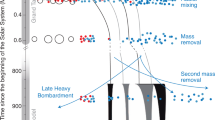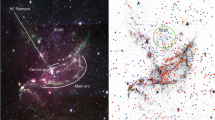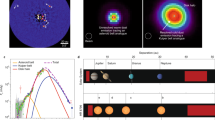Abstract
The discovery of the first member of the Kuiper belt1—a formerly hypothetical ancient reservoir of objects located beyond Neptune's orbit—started a revolution in our understanding of the outer Solar System: there is no longer a sharp edge at Pluto's orbit. About 60 Kuiper-belt objects, intermediate in size between comets and planets, are now known2 to exist on stable circular orbits around the Sun, and no doubt many more objects await discovery. But owing to the recent discovery and intrinsic faintness of these objects, little has been done to explore their physical and chemical properties3,4,5,6,7,8. Here we report the results of a two-year survey of the broad-band optical colours of about one-quarter of the known Kuiper-belt objects. We find that their colours indicate the presence of two distinct populations: one consists of objects whose surface colours are only slightly redder than the colour of the Sun, while the other consists of the reddest objects known in the Solar System.
This is a preview of subscription content, access via your institution
Access options
Subscribe to this journal
Receive 51 print issues and online access
$199.00 per year
only $3.90 per issue
Buy this article
- Purchase on Springer Link
- Instant access to full article PDF
Prices may be subject to local taxes which are calculated during checkout

Similar content being viewed by others
References
Jewitt, D. & Luu, J. Discovery of the candidate Kuiper belt object 1992 QB1. Nature 362, 730–732 (1993).
Marsden, B. G. List of Transneptunian Objects ((1997)); available at http://cfa-www.harvard.edu/cfa/ps/lists/TNOs.html
Luu, J. & Jewitt, D. Color diversity among the centaurs and kuiper belt objects. Astron. J. 112, 2310–2318 (1996).
Brown, W. & Luu, J. X. CCD photometry of the centaur 1995 GO. Icarus 126, 218–224 (1997).
Romanishin, W., Tegler, S. C., Levine, J. & Butler, N. BVR photometry of centaur objects 1995 GO, 1993 HA2, and 5145 Pholus. Astron. J. 113, 1893–1898 (1997).
Tegler, S. C. & Romanishin, W. The extraordinary colors of trans-neptunian objects 1994 TB and 1993 SC. Icarus 126, 212–217 (1997).
Tegler, S. C. et al. Photometry of the trans-neptunian object 1993 SC. Astron. J. 114, 1230–1233 (1997).
Weintraub, D. A., Tegler, S. C. & Romanishin, W. Visible and near infrared photometry of the centaur objects 1995 GO and 5145 Pholus. Icarus 128, 456–463 (1997).
Landolt, A. U. UBVRI photometric standard stars in the magnitude range 11.5 < V < 16.0 around the celestial equator. Astron. J. 104, 340–371 (1992).
Richmond, M. W. Automated photometry at Leuschner observatory. Int. Amateur-Professional Photoelectr. Photom. Commun. 55, 21–30 (1994).
Stern, A. & Campins, H. Chiron and the centaurs: escapees from the Kuiper belt. Nature 382, 507–510 (1996).
Andronico, G., Baratta, G. A., Spinella, F. & Strazzulla, G. Optical evolution of laboratory produced organics: applications to Phoebe, Iapetus, outer belt asteroids, and cometary nuclei. Astron. Astrophys. 184, 333–336 (1987).
Thompson, R. W., Murray, B. G. J. P. T., Khare, B. N. & Sagan, C. Coloration and darkening of methane clathrate and other ices by charged particle irradiation: applications to the outer solar system. J. Geophys. Res. 92, 14933–14947 (1987).
Bus, S. J., Schleicher, Bowel E., & A'Hearn, M. F. Detection of CN emission from 2060 Chiron. Science 251, 774–777 (1991).
Bus, S. J., A'Hearn, M. F., Bowell, E. & Stern, S. A. 2060 Chiron: evidence for activity near aphelion. Icarus (submitted).
Degewij, J. & Van Houten, C. J. in Asteroids (ed. Gehrels, T.) 417–435 (Univ. Arizona Press, Tucson, (1979)).
Tody, D. in Astronomical Data Analysis Software and Systems II (eds Hanisch, R. J., Brissenden, R. J. V. & Barnes, J.) 173 (ASP Conf. Ser. 52, Tucson, (1993)).
Acknowledgements
We thank the NASA Origins of Solar Systems program for support of this work, and the Steward Observatory Telescope Allocation Committee for consistent allocation of telescope time.
Author information
Authors and Affiliations
Corresponding author
Rights and permissions
About this article
Cite this article
Tegler, S., Romanishin, W. Two distinct populations of Kuiper-belt objects. Nature 392, 49–51 (1998). https://doi.org/10.1038/32108
Received:
Accepted:
Issue Date:
DOI: https://doi.org/10.1038/32108
This article is cited by
-
Insights into Planet Formation from Debris Disks: I. The Solar System as an Archetype for Planetesimal Evolution
Space Science Reviews (2016)
Comments
By submitting a comment you agree to abide by our Terms and Community Guidelines. If you find something abusive or that does not comply with our terms or guidelines please flag it as inappropriate.



